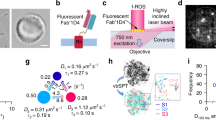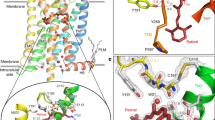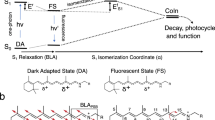Abstract
Retinal rods signal the activation of a single receptor molecule by a photon1. To ensure efficient photon capture, rods maintain about 109 copies of rhodopsin densely packed into membranous disks2. But a high packing density of rhodopsin may impede other steps in phototransduction that take place on the disk membrane3, by restricting the lateral movement of, and hence the rate of encounters between, the molecules involved4,5,6. Although it has been suggested that lateral diffusion of proteins on the membrane sets the rate of onset of the photoresponse7, it was later argued that the subsequent processing of the complexes was the main determinant of this rate8,9. The effects of protein density on response shut-off have not been reported. Here we show that a roughly 50% reduction in protein crowding achieved by the hemizygous knockout of rhodopsin in transgenic mice accelerates the rising phases and recoveries of flash responses by about 1.7-fold in vivo. Thus, in rods the rates of both response onset and recovery are set by the diffusional encounter frequency between proteins on the disk membrane.
This is a preview of subscription content, access via your institution
Access options
Subscribe to this journal
Receive 51 print issues and online access
$199.00 per year
only $3.90 per issue
Buy this article
- Purchase on Springer Link
- Instant access to full article PDF
Prices may be subject to local taxes which are calculated during checkout




Similar content being viewed by others
References
Baylor, D. A., Lamb, T. D. & Yau, K.-W. Responses of retinal rods to single photons. J. Physiol. (Lond.) 288, 613–634 (1979).
Pugh, E. N. Jr & Lamb, T. D. Amplification and kinetics of the activation steps in phototransduction. Biochim. Biophys. Acta 1141, 111–149 (1993).
Saxton, M. J. & Owicki, J. C. Concentration effects on reactions in membranes: rhodopsin and transducin. Biochim. Biophys. Acta 979, 27–34 (1989).
Peters, R. & Cherry, R. J. Lateral and rotational diffusion of bacteriorhodopsin in lipid bilayers: experimental test of the Saffman-Delbruck equations. Proc. Natl Acad. Sci. USA 79, 4317–4321 (1982).
Tank, D. W., Wu, E. S., Meers, P. R. & Webb, W. W. Lateral diffusion of gramicidin C in phospholipid multibilayers. Effects of cholesterol and high gramicidin concentration. Biophys. J. 40, 129–135 (1982).
Tilton, R. D., Gast, A. P. & Robertson, C. R. Surface diffusion of interacting proteins. Effect of concentration on the lateral mobility of adsorbed bovine serum albumin. Biophys. J. 58, 1321–1326 (1990).
Kahlert, M. & Hofmann, K. P. Reaction rate and collisional efficiency of the rhodopsin-transducin system in intact retinal rods. Biophys. J. 59, 375–386 (1991).
Bruckert, F., Chabre, M. & Vuong, T. M. Kinetic analysis of the activation of transducin by photoexcited rhodopsin. Influence of the lateral diffusion of transducin and competition of guanosine diphosphate and guanosine triphosphate for the nucleotide site. Biophys. J. 63, 616–629 (1992).
Heck, M. & Hofmann, K. P. G-protein-effector coupling: a real-time light-scattering assay for transducin–phosphodiesterase interaction. Biochemistry 32, 8220–8227 (1993).
Pugh, E. N. Jr, Nikonov, S. & Lamb, T. D. Molecular mechanisms of vertebrate photoreceptor light adaptation. Curr. Opin. Neurobiol. 9, 410–418 (1999).
Naqvi, K. R. Diffusion-controlled reactions in two-dimensional fluids: discussion of measurements of lateral diffusion of lipids in biological membranes. Chem. Phys. Lett. 28, 280–284 (1974).
Pink, D. A. Protein lateral movement in lipid bilayers. Simulation studies of its dependence upon protein concentration. Biochim. Biophys. Acta 818, 200–204 (1985).
Liebman, P. A. & Entine, G. Lateral diffusion of visual pigment in photoreceptor disk membranes. Science 185, 457–459 (1974).
Poo, M. & Cone, R. A. Lateral diffusion of rhodopsin in the photoreceptor membrane. Nature 247, 438–441 (1974).
Lem, J. et al. Morphological, physiological, and biochemical changes in rhodopsin knockout mice. Proc. Natl Acad. Sci. USA 96, 736–741 (1999).
Palczewski, K. et al. Crystal structure of rhodopsin: A G protein-coupled receptor. Science 289, 739–745 (2000).
Leskov, I. B. et al. The gain of rod phototransduction: reconciliation of biochemical and electrophysiological measurements. Neuron 27, 525–537 (2000).
Chen, J., Makino, C. L., Peachey, N. S., Baylor, D. A. & Simon, M. I. Mechanisms of rhodopsin inactivation in vivo as revealed by a COOH- terminal truncation mutant. Science 267, 374–377 (1995).
Calvert, P. D., Ho, T. W., LeFebvre, Y. M. & Arshavsky, V. Y. Onset of feedback reactions underlying vertebrate rod photoreceptor light adaptation. J. Gen. Physiol. 111, 39–51 (1998).
Koutalos, Y. & Yau, K.-W. Regulation of sensitivity in vertebrate rod photoreceptors by calcium. Trends Neurosci. 19, 73–81 (1996).
Pepperberg, D. R. et al. Light-dependent delay in the falling phase of the retinal rod photoresponse. Vis. Neurosci. 8, 9–18 (1992).
Nikonov, S., Engheta, H. & Pugh, E. N. Jr Kinetics of recovery of the dark-adapted salamander rod photoresponse. J. Gen. Physiol. 111, 7–37 (1998).
Dodd, R. L., Makino, C. L., Chen, J., Simon, M. I. & Baylor, D. A. Visual transduction in transgenic mouse rods lacking recoverin. Invest. Ophthalmol. Vis. Sci. 36, S641 (1995).
Skiba, N. P., Hopp, J. A. & Arshavsky, V. Y. The effector enzyme regulates the duration of G protein signaling in vertebrate photoreceptors by increasing the affinity between transducin and RGS protein. J. Biol. Chem. 275, 32716–32720 (2000).
Tsang, S. H. et al. Role for the target enzyme in deactivation of photoreceptor G protein in vivo. Science 282, 117–121 (1998).
Makino, E. R., Handy, J. W., Li, T. & Arshavsky, V. Y. The GTPase activating factor for transducin in rod photoreceptors is the complex between RGS9 and type 5 G protein β subunit. Proc. Natl Acad. Sci. USA 96, 1947–1952 (1999).
Smith, H. G. Jr, Stubbs, G. W. & Litman, B. J. The isolation and purification of osmotically intact discs from retinal rod outer segments. Exp. Eye Res. 20, 211–217 (1975).
Yuan, C., Chen, H., Anderson, R. E., Kuwata, O. & Ebrey, T. G. The unique lipid composition of gecko (Gekko Gekko) photoreceptor outer segment membranes. Comp. Biochem. Physiol. B 120, 785–789 (1998).
Sung, C.-H., Makino, C., Baylor, D. & Nathans, J. A rhodopsin gene mutation responsible for autosomal dominant retinitis pigmentosa results in a protein that is defective in localization to the photoreceptor outer segment. J. Neurosci. 14, 5818–5833 (1994).
Yau, K.-W. & Nakatani, K. Electrogenic Na–Ca exchange in retinal rod outer segment. Nature 311, 661–663 (1984).
Acknowledgements
We thank P. Farabella, M. McClellan and M. Maude for technical assistance; R. Lefkowitz, A. Dizhoor, W. Smith, R. Lee, M. Simon, E. Makino and V. Arshavsky for antibodies; and E. Pugh Jr, D. Baylor and V. Arshavsky for comments on the manuscript. This work was supported by the E. Mathilda Ziegler Foundation (C.L.M.), Milton Fund (C.L.M.), the NIH (P.D.C., J.L., R.E.A.), Lion's of Massachusetts (C.L.M., J.L.), Fight for Sight (J.L.), Research to Prevent Blindness (C.L.M., J.L., R.E.A.), Foundation Fighting Blindness (J.L., R.E.A.), and the US Civilian Research and Development Foundation (V.I.G.).
Author information
Authors and Affiliations
Corresponding author
Rights and permissions
About this article
Cite this article
Calvert, P., Govardovskii, V., Krasnoperova, N. et al. Membrane protein diffusion sets the speed of rod phototransduction. Nature 411, 90–94 (2001). https://doi.org/10.1038/35075083
Received:
Accepted:
Issue Date:
DOI: https://doi.org/10.1038/35075083
This article is cited by
-
A complex genomic architecture underlies reproductive isolation in a North American oriole hybrid zone
Communications Biology (2023)
-
Loss of PRCD alters number and packaging density of rhodopsin in rod photoreceptor disc membranes
Scientific Reports (2020)
-
Mutation-independent rescue of a novel mouse model of Retinitis Pigmentosa
Gene Therapy (2013)
-
Phototransduction in mouse rods and cones
Pflügers Archiv - European Journal of Physiology (2007)
-
Functional membrane diffusion of G-protein coupled receptors
European Biophysics Journal (2007)
Comments
By submitting a comment you agree to abide by our Terms and Community Guidelines. If you find something abusive or that does not comply with our terms or guidelines please flag it as inappropriate.



